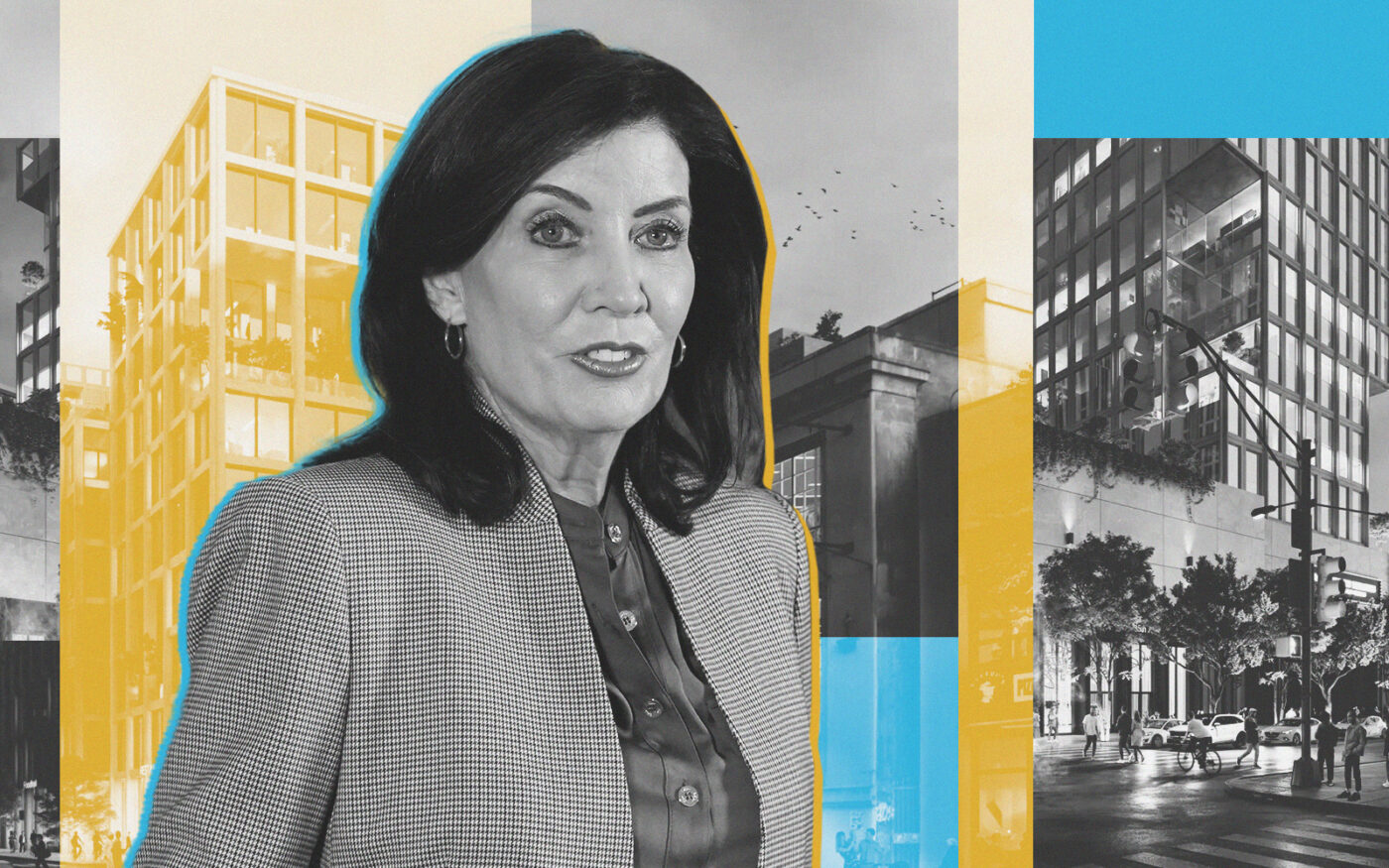 “I wouldn’t use it, I would just lock the door”: Landlords pan new rehab law
“I wouldn’t use it, I would just lock the door”: Landlords pan new rehab law
Trending
Developers have a new tax break. Now they must figure it out
485x comes with wage, affordability requirements

The new tax break 485x aims to make projects like a stalled $2 billion Astoria development possible. Does it?
Under the program, wages and benefits for construction workers at Innovation QNS must be worth at least $40 per hour. For the developers, Silverstein Properties and two partners, it could have been worse: Their site is just outside of one of the areas where workers on projects larger than 150 units must be paid even more.
Not only does the citywide program add labor costs, it also limits rents. To get 485x, Innovation QNS has to make at least 25 percent of its apartments affordable for households earning no more than the area median income, and 80 percent of AMI on average.
That should be feasible: To get new zoning from the City Council in 2022, the developers pledged to set rents for nearly half of the apartments at below market rate, with more than 25 percent for those earning less than 50 percent of AMI.
These are the kinds of details developers will be poring over in the coming months as they figure out whether current and future projects will be viable under the new property tax break, which was folded into the state budget.
“It is going to take some time for the market to digest it,” said Ofer Cohen, founder and chair of Brooklyn commercial brokerage TerraCRG. “But having a program is better than not having a program. Certainty is always better than uncertainty.”
The property tax break 421a expired in June 2022 because Democratic legislators considered it too generous. Construction of rental buildings rarely pencils out without a subsidy, so new filings in the city came to a virtual halt. It took nearly two years for lawmakers to create a new one.
The 485x program has higher wage and deeper affordability requirements than 421a. The initial response from real estate professionals has been happiness that a property tax benefit was restored. Some are concerned, however, that developments possible under the old program will no longer be.
The new one provides property tax exemptions for up to 40 years, and eliminates the highest income band permitted for “affordable” units under the previous program: 130 percent of the area median income.
“We knew that 130 percent AMI was going out the window,” said Alvin Schein, a founding partner at Seiden & Schein. Some landlords actually had a difficult time renting out those units. The 130 percent AMI units forced owners and prospective tenants to navigate city bureaucracy and were a punching bag for critics, who ridiculed their “affordable” label.
“I think 130 was a mistake,” Schein said. “It helped give 421a a bad name.”
Depending on project size and location, developers receiving 485x must set aside 20 or 25 percent of apartments for those earning a weighted average of 60 or 80 percent of the AMI. The lowest AMIs are required at the largest projects.
Emily Goldstein, director of organizing and advocacy for the Association for Neighborhood and Housing Development, said the changes to affordability levels still do not address the “fundamental problem” with 421a, which is that it provides a significant benefit for buildings that have mostly market-rate housing.
She noted that the state budget also failed to create a state-based housing voucher program, a proposal that enjoyed widespread support from tenant and real estate groups.
“It should have been a no-brainer,” she said. “There was no need to compromise. The broad spectrum of everyone who deals with housing supports this program.”
After the Real Estate Board of New York and the Building and Construction Trades Council failed to reach an agreement on the wage requirements for 485x, Gov. Kathy Hochul went with a standard closer to what the unions wanted: a percentage of prevailing wage rates, rather than an average for wages across a project.
The highest wage requirement is for projects with 150 or more units and south of 96th Street in Manhattan, as well as Williamsburg, East Williamsburg and Greenpoint in Brooklyn and Long Island City in Queens. Construction workers on those projects must get wages and benefits worth at least $72.45 per hour or 65 percent of the prevailing rate, whichever is less.
Workers on projects of that size within parts of Astoria and Queensbridge in Queens, as well as Dumbo and Brooklyn Heights in Brooklyn, must be paid the lesser of $63 per hour or 60 percent of the prevailing rate. The governor’s office did not respond to a request seeking information on how these geographies were selected.
Ahead of the budget deal, REBNY reached an agreement with the Mason Tenders District Council to set a wage and benefit floor of $40 per hour for projects with 100 units or more, regardless of location.
Joseph Geiger, head of the New York City District Council of Carpenters, called 485x a “step in the right direction,” and credited his union’s efforts for the move away from an average wage system, which was used under the old 421a.
Still, he said, 485x does not do enough for construction workers.
“Unfortunately, the wage standard does not apply to enough of the city and excludes key areas that are primed for development, like the Bronx,” he said in a statement.
The carpenters plan to continue advocating for an expansion of the areas where a wage standard would apply, but the legislature is not likely to overhaul 485x before it expires in 2034.
For its part, REBNY has said that the wage and increased affordability requirements will mean 485x will create less housing than 421a did.
Schein said it is too early to tell how the new program will play out, but noted that interest rates remain high and lenders squeamish about financing ground-up construction.
“From the developers’ point of view, every dollar counts, and having a higher wage rate makes it more difficult,” Schein said. “What they’ll have to do to make it work, that remains to be seen.”
Developers who put foundation footings in place by June 15, 2022, now have until 2031 to complete their 421a projects because the state budget extended the construction deadline by five years. Those developers cannot opt to receive 485x, however.
Innovation QNS did not vest under the old program, so it will almost certainly apply for 485x. Representatives for the developers declined to comment, but Hal Rosenbluth, head of Kaufman-Astoria Studios, a partner in Innovation QNS, told The City, “I am hoping the deal allows the math to come out right.”
Earlier this year, 18 projects in Gowanus qualified for an alternative to 421a. It involves the state taking ownership of the properties and leasing them back to the developers in order to provide benefits that mirrored the tax break. These projects are likely to opt for 421a, given the extended construction deadline.
The new program has a longer runway than its predecessor, 10 years, so developers have time to figure out the program. But those with significant carrying costs on their projects are likely to start soon.
Developers have other opportunities to use the tax break. David Schwartz of Slate Property Group said a provision of the budget that eliminates the city’s cap on residential density could lead to office buildings being torn down to make way for housing.
The legislation offers a partial tax exemption for office-to-residential conversions, but such projects can be complicated and costly. Starting fresh with 485x may prove more attractive, depending on the site.
Overall, Schwartz said the housing package in the budget was a positive step. He had feared a repeat of last year, when a housing deal fell apart at the end of the legislative session.
“I was skeptical that anything would get done,” Schwartz said. “I think we’re really happy that we made some progress.”
Read more
 “I wouldn’t use it, I would just lock the door”: Landlords pan new rehab law
“I wouldn’t use it, I would just lock the door”: Landlords pan new rehab law
 Housing deal finally passes; here are the details
Housing deal finally passes; here are the details
 Housing deal could rescue Halletts North, other stalled projects
Housing deal could rescue Halletts North, other stalled projects



